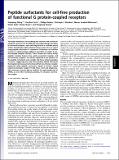Peptide surfactants for cell-free production of functional G proteincoupled receptors
Author(s)
Wang, Xiaoqiang; Corin, Karolina A.; Baaske, Philipp; Wienken, Christoph J.; Jerabek-Willemsen, Moran; Duhr, Stefan; Braun, Dieter; Zhang, Shuguang; ... Show more Show less
DownloadZhang-2011-May-Peptide surfactants for cell-free production of functional G proteincoupled receptors.pdf (1.342Mb)
PUBLISHER_POLICY
Publisher Policy
Article is made available in accordance with the publisher's policy and may be subject to US copyright law. Please refer to the publisher's site for terms of use.
Terms of use
Metadata
Show full item recordAbstract
Two major bottlenecks in elucidating the structure and function of membrane proteins are the difficulty of producing large quantities of functional receptors, and stabilizing them for a sufficient period of time. Selecting the right surfactant is thus crucial. Here we report using peptide surfactants in commercial Escherichia coli cell-free systems to rapidly produce milligram quantities of soluble G protein-coupled receptors (GPCRs). These include the human formyl peptide receptor, human trace amine-associated receptor, and two olfactory receptors. The GPCRs expressed in the presence of the peptide surfactants were soluble and had α-helical secondary structures, suggesting that they were properly folded. Microscale thermophoresis measurements showed that one olfactory receptor expressed using peptide surfactants bound its known ligand heptanal (molecular weight 114.18). These short and simple peptide surfactants may be able to facilitate the rapid production of GPCRs, or even other membrane proteins, for structure and function studies.
Date issued
2011-05Department
Massachusetts Institute of Technology. Center for Biomedical EngineeringJournal
Proceedings of the National Academy of Sciences of the United States of America
Publisher
National Academy of Sciences (U.S.)
Citation
Wang, X. et al. “Peptide surfactants for cell-free production of functional G protein-coupled receptors.” Proceedings of the National Academy of Sciences 108.22 (2011): 9049-9054. ©2011 by the National Academy of Sciences.
Version: Final published version
ISSN
1091-6490